RSN Crewelwork Course Day 1 - framing
We've all been told or have read somewhere that the twill fabric must be "as tight as a drum" to ensure the best results. Until I used a slate frame, I'd never really experienced just how tight "as tight as a drum" could be! It takes time ( a lot!) and effort (you'll need to use your muscles) but it is completely worth both the time and effort.I'll talk about what we did on the course to frame up the linen twill. I was very busy doing the framing and didn't get photos of every step, but hopefully you'll understand.A slate frame is made of 4 pieces of wood. The top and bottom have very thick, strong webbing attached to the wood. The sides have holes in them which allow the frame to be stretched apart, thus tightening the fabric. I asked why it's called a slate frame and one theory is that it's similar in shape and design to the old fashioned slates that children used in school.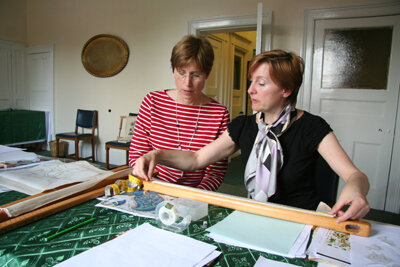 Before mounting your fabric on the frame you need to mark the center to the webbing that's attached to the frame. This ensures that the center of the twill will be attached to the center of the frame. Rather than measuring the fabric to find the middle, we were taught to measure the wood and find the middle that way. Wood doesn't stretch while fabric does so using the wood ensures that the middle will be accurately measured.
Before mounting your fabric on the frame you need to mark the center to the webbing that's attached to the frame. This ensures that the center of the twill will be attached to the center of the frame. Rather than measuring the fabric to find the middle, we were taught to measure the wood and find the middle that way. Wood doesn't stretch while fabric does so using the wood ensures that the middle will be accurately measured.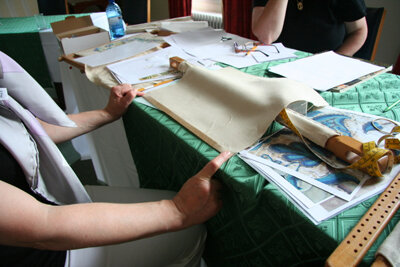 Next you need to fold over the top and bottom of the twill and crease it with your fingernail to make a good fold. (You could iron it but it really isn't necessary!) It's important to fold the twill as it adds strength to the fabric. You'll be sewing this folded edge to the webbing that's part of the frame, Attach the folded end to the webbing and whip stitch them together using heavy duty button thread. You must put the back side of your linen twill next to the back side of the webbing. When you pin them together, put the pins in vertically not horizontally to keep the webbing and the twill from puckering.
Next you need to fold over the top and bottom of the twill and crease it with your fingernail to make a good fold. (You could iron it but it really isn't necessary!) It's important to fold the twill as it adds strength to the fabric. You'll be sewing this folded edge to the webbing that's part of the frame, Attach the folded end to the webbing and whip stitch them together using heavy duty button thread. You must put the back side of your linen twill next to the back side of the webbing. When you pin them together, put the pins in vertically not horizontally to keep the webbing and the twill from puckering.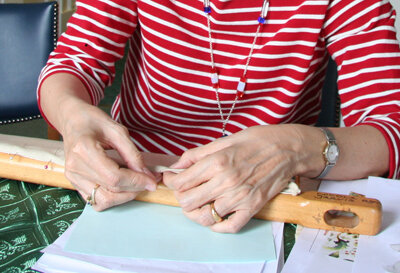 After you've sewn the top and bottom of the linen twill to the top and bottom of the frame, it's time to attach a piece of twill tape to the sides of the linen twill. This strengthens the side of the linen twill so when you lace string through both the linen twill and the twill tape the fabric won't tear.
After you've sewn the top and bottom of the linen twill to the top and bottom of the frame, it's time to attach a piece of twill tape to the sides of the linen twill. This strengthens the side of the linen twill so when you lace string through both the linen twill and the twill tape the fabric won't tear.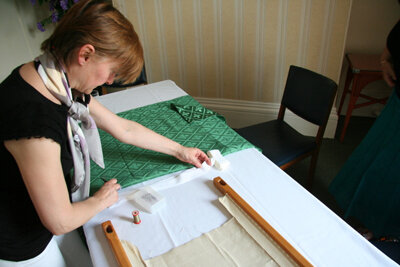 At this point you need to stretch the twill but sliding/pulling the top and bottom away from each other and putting the metal pegs in the holes on the sides of the frame to hold it in place. It won't be super tight but don't worry - you'll stretch it again later to tighten it up more.
At this point you need to stretch the twill but sliding/pulling the top and bottom away from each other and putting the metal pegs in the holes on the sides of the frame to hold it in place. It won't be super tight but don't worry - you'll stretch it again later to tighten it up more.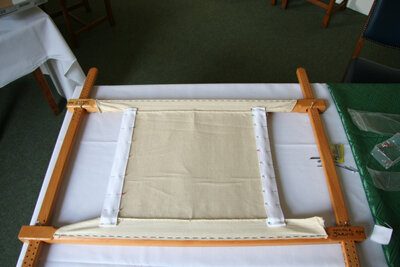 Again, pinning vertically attach the twill tape to the linen twill. Then stitch the twill tape to the linen twill fabric using buttonhole thread.
Again, pinning vertically attach the twill tape to the linen twill. Then stitch the twill tape to the linen twill fabric using buttonhole thread.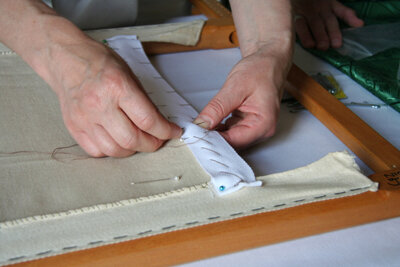 The next step is to lace the fabric to the sides of the frame. We used simple cotton string (the kind you get at the hardware store) and a huge curved needle. Lacing the fabric takes time and a LOT of strength to pull the string tightly enough. It's really important to keep the side of the fabric straight. This process is complex enough so I"ll take time when I get home to write up a clear and complete tutorial.
The next step is to lace the fabric to the sides of the frame. We used simple cotton string (the kind you get at the hardware store) and a huge curved needle. Lacing the fabric takes time and a LOT of strength to pull the string tightly enough. It's really important to keep the side of the fabric straight. This process is complex enough so I"ll take time when I get home to write up a clear and complete tutorial.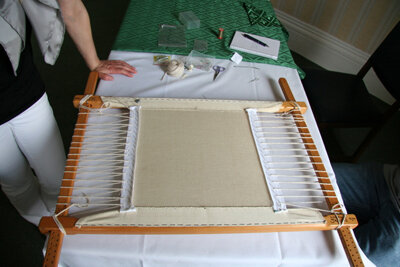 Now the linen twill really is drum tight! Next step is transferring the design to the twill - look for that next time!
Now the linen twill really is drum tight! Next step is transferring the design to the twill - look for that next time! Here's Nicola Jarvis, our tutor, very happy because we're all framed up. Whew!
Here's Nicola Jarvis, our tutor, very happy because we're all framed up. Whew!
